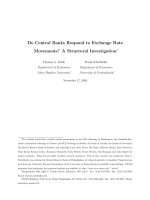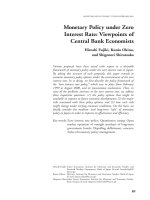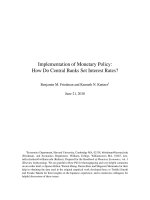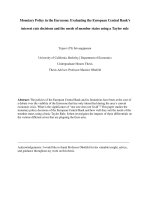Thuyết trình Can central banks’ monetary policy be described by a linear (augmented) Taylor
Bạn đang xem bản rút gọn của tài liệu. Xem và tải ngay bản đầy đủ của tài liệu tại đây (1.76 MB, 90 trang )
Can central bank’s
monetary policy
be described by a
linear (augmented)
Taylor rule or by a
nonlinear rule?
BỘ MÔN
TÀI CHÍNH QUỐC TẾ
GS.TS Trần Ngọc Thơ
GĐ A201 (E303)
23
Số 4
Danh sách nhóm
1. Nguyễn Thị Ngọc Cẩm 3. Vũ Quỳnh Hoa
2. Đoàn Thị Thanh Thủy 4. Tạ Quang Vũ
GVHD:
Lớp:
Khóa:
Paper:
Vítor Castro
(2011)
1
•
Inroduction
2
•
Literature review
3
•
The linear Taylor rule
4
•
The nonlinear Taylor rule
5
•
Conclusions
CONTENT
Nonlinear rule
Augmented with a financial conditions index
Forward-looking version
The original Taylor Rule
•
Is Central Banks reacting
differently to levels of
inflation/ output gap above
and below the target
•
Central banks target
expected Inflation and
output gap instead of past
or current value
•
Simple linear relation
beween Interest Rate,
Inflation and The Output
Gap
ASTRACT
•
Asset prices
•
Financial variables
CONTENT OF PAPER
ASTRACT
The monetary behaviour of the European Central Bank
(ECB) and Bank of England (EOB) is best descibed by a
nonlinear rule
The behaviour of the Federal Reserve of the United
States (FED) can be well descibed by a linear Taylor rule
Only ECB is reacting to financial conditions
RESULT OF PAPER
•
Purpose of paper
•
Methodology and data
•
Paper’s meaning
1. INTRODUCTION
•
THE ORIGINAL TAYLOR RULE
1. INTRODUCTION
The original Taylor rule establishes a simple linear
relation beween Interest Rate, Inflation and The
Output Gap
PURPOSE OF THE PAPER
•
THE ORIGINAL TAYLOR RULE
•
The nominal short-term interest rate – the monetary
policy instrument
•
Equilibrium real rate
•
Inflation at t
•
Target Inflation
•
Output gap at t
•
Potential output gap
•
1. INTRODUCTION
PURPOSE OF THE PAPER
1. INTRODUCTION
PURPOSE OF THE PAPER
Extension 1: Forward-looking version
•
Use expected Inflation and Output gap instead of past
or current value
Extension 2: Augmented with a financial conditions
index
•
Central Bank are targeting the revelant economic
information contained in a group of financial variables
1st
PURPOSE
Estimate a linear Taylor rule for the Eurozone,
US and UK
Augmented with a financial conditions index
capture asset proces and financial variables
The weight of each asset and financial variable
is allowed to vary over the time
1. INTRODUCTION
PURPOSE OF THE PAPER
Extension 3: Consider nonlinearities in the analyst
of monetary policy
•
The central bank might assign different weights
to expected negative and possitive inflation and
output gap in its loss function
1. INTRODUCTION
PURPOSE OF THE PAPER
2nd
PURPOSE
Applying a nonlinear model to the study of the
ECB’s monetary policy
Is the ECB reacting differently to levels of
inflation above and below the target?
Does the ECB attempt to hit the inflation
target precisely or keep inflation with a certain
range?
1. INTRODUCTION
PURPOSE OF THE PAPER
2nd
PURPOSE
Extent the nonlinear specification of the Taylor
rule with the financial index used in the linear
estimation
After controlling for nonlinearities, the ECB
and other two central banks are still (or not)
reacting to the information contained in that
index
1. INTRODUCTION
PURPOSE OF THE PAPER
1. INTRODUCTION
METHODOLOGY AND DATA
Linear rule Nonlinear rule
Generalized Method of
Moments (GMM)
A smooth transition
regression (STR) model
Data (monthly)
Eurozone : January 1999 – December 2007
US : October 1992 – December 2007
UK : October 1992 – December 2007
Forward-
looking
version
Clarida et al.
(1998, 2000)
Sauer and
Sturm (2007)
Fourcans and
Vranceanu
(2004)
2. LITERATURE REVIEW
That practice allows the central bank to take various revelant
variables into account when it forming its forecasts
Exchange
rate
deviations
Fourcant and Vranceanu (2004) present some
evidence of an ECB respone to the exchange rate
deviations from its average
Chadha et el. (2004) found a similar result for
- The FED
- Bank of England
- Bank of Japan
Libik and Schorfheide (2007) found a similar result
for
- Central Banks of Canada
- Central Banks of England
2. LITERATURE REVIEW
Extent by cosidering the effect of other variables in the
conduct of monetary policy
The role
of
monetary
supply in
ECB
reaction
function
Fendel and Frenkel (2006)
Surico (2007b)
It does not affect the ECB’s behaviour
directly
But it is a good instrument to predict inflation
2. LITERATURE REVIEW
Extent by cosidering the effect of other variables in the
conduct of monetary policy
2. LITERATURE REVIEW
•
Cecch et al. (2000)
•
Borio & Lowe(2002)
•
Googhart & Hofmann (2002)
•
…
STRONG SUPPORT AND EVIDENCE
The role of asset prices
Central Banks target asset
prices
Do not agree
with an ex-
ante control
over asset
prices
•
Bernanke & Gertler (1999, 2001)
•
Bullard & Schaling (2002)
2. LITERATURE REVIEW
The role of asset prices
Do not agree
with an ex-
ante control
over asset
prices
•
Bernanke & Gertler (1999, 2001)
•
Bullard & Schaling (2002)
Once the predictive content of asset prices for inflation has been accounted
for, monetary authorities should not respond to movements in asset price.
Instead, central banks should act only if it is expected that they affect
inflation forecast or after the burst of a financial bubble in order to avoid
damages to the real economy.
2. LITERATURE REVIEW
The Future market and Financial stability
Analyse the interactions between monetary policy and future market in the
context of a linear reaction function.
Evidence supporting the inclusion of futures prices tin the centtral bank’s
reaction function as a proxy for financial stability
Drifill at al. (2006)
Monetary policy should also react to house price due to their effects on
consumption
Kajuth (forthcoming)
2. LITERATURE REVIEW
The Future market and Financial stability
They built and use a financial conditional indicator that includes the
exchange rate, share prices in the estimation of a Taylor rule for some
central banks.
Their results show that this indicator can be helpful in the modelling the
conduct of monetary policy
Montagnoli and Napolitano (2005)
First aims of paper is simply to estimate a linear Taylor rule for
the Eurozone, US and UK, where the information from some
financial variables is accounted for to shed some more light on
its (un)important
2. LITERATURE REVIEW
•
In reality, the central bank can have asymmetric
preference and, therefore, follow a nonlinear Taylor rule.
•
If the central bank is indeed assigning different weights to
negative and positive inflation and output gaps in it loss
function.
•
Then a nonlinear Taylor rule seems to be more adequate
to explain the behavior of monetary policy.
•
Asymmetries in monetary policy can result from a
nonlinear macroeconomic model (Dolado et al., 2005),
nonlinear central bank preferences (Dolado et al.,
2000; Nobay and Pee, 2003; …) or both (Surico, 2007b)
The nonlinear Taylor rule
2. LITERATURE REVIEW
The nonlinear Taylor rule
•
ECB monetary policy for the period Jan 1999- Dec 2004.
•
A linear GMM model resulting from the derivation of a loss funtion with
asymmetric preferences and considering a convex aggregate supply
curve.
•
Output contractions imply larger monetary policy respones than output
gap expansions of the same size, but no asymmetric respone is found
for inflation
Surico (2007b)
Apply the
nonlinear
Taylor rule
in this
paper
- More data available
- A different model – a nonlinear model (with forward-
looking expectations)
Expect to find evidence of an asymmetric respone
of the ECB to the inflation as well
Account the asymmetric in the macroeconomic model
and in the central bank preferences implicitly and
generalizes in Taylor rule in the traditional of Clarida el
al., (1998, 2000)
The asymmetric are accounted for by a separate
analyst for inflation above and below the target
Anser the question of whether a central bank follows a
point target or a target rangr for inflation
2. LITERATURE REVIEW
The nonlinear Taylor rule
2. LITERATURE REVIEW
The nonlinear Taylor rule
•
Apply a nonlinear quadratic logistic smooth transition model to the
BOE’s monetary policy.
•
Concentrate on the policy of inflation targeting set up in 1992 and find
evidence of nonlinearities in the conduct of monetary policy over the
period 1992-2000.
•
Result: UK monetary authorities attempt to keep inflation within a
range rather than pursuing a point target and tend to react more
actively than to downward deviations of inflation away the target
range.
•
The only shortcoming of the paper is not providing a test for the
adequacy of the model. This is a key issue that will be covered in this
study
Martin and Milas (2004)
2. LITERATURE REVIEW
The nonlinear Taylor rule
•
Apply a simple logistic smooth transition repgerrion model to the
monetary policy of the FED over the period 1985-2005.
•
Find the presence of nonlinearities: once inflation approaches a certain
threshold, the Fed begins to respond more forcefully to inflation.
•
However, this paper does not take into account the degree of interest
rate smoothing or the possibility of the Taylor rule being forward-
looking.
Petersen (2007)









